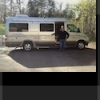
The flies and mosquitoes are gone, so are the crowds and the whole peninsula is bursting with bright yellows and reds as the annual fall foliage change explodes the hardwoods into jaw-dropping displays. And the sunsets are to die for.
This year, the color change is later than normal. We came up last Thursday and it was just starting. As we head back downstate today five days later, it’s clear that its moving fast now. This coming weekend and next should be peak times. Jennifer and I love the UP. This is our third extended trip up here since February.
Yes, that’s right. I said February. we drove the Roadtrek up and camped out at Tahquamenon Falls with 28 inches of snow on the ground and minus 8 degree Fahrenheit temperatures. No problem. You can see what that was like here.
And we came back up a couple of months ago during peak bug and biting fly time. It was still beautiful – as this shows – but much more uncomfortable.
This trip is our favorite. And we used it to visit our favorite campground – the beautiful Twelvemile Beach National Parks Service campground on Lake Superior, part of the Pictured Rocks National Seashore. Located 15 miles west of Grand Marais off Alger County Road H-58, this no-hookup 36-site campground is located on a high sandy plateau above Twelvemile Beach, one of the most remote and beautiful stretches of Lake Superior you will find anywhere in the UP. Half the sites are generator free and that’s where we headed, selecting site #25.
With our all electric Roadtrek eTrek and its solar power, we needed no such noisy power source.
It got cold. The first frost warning of the year for the UP was issued last night. When I got up at 3 AM to use the bathroom, the outside temp read 35 degrees. Our Webosto heater was adjusted to give us a perfect 62 degree inside temp.
This is a very hard park to get into – during the summer. This late into September, we had lots of lakefront spots to choose from. This is bear country. So if you come here, keep a neat campsite and use the bearproof food storage units.
There are pit toilets here, fire rings and picnic tables. The campground connects to several hiking trails.
Over the next few weeks, well have reviews and stories about various places to visit up here that will help you plan a trip to the UP next year. But if you want to squeeze in a trip yet this season, better hurry. Most campgrounds shut down for the winter in October. Some, like Twelvemile Beach, shut down Oct. 1.
- Read more...
- 0 comments
- 1356 views

